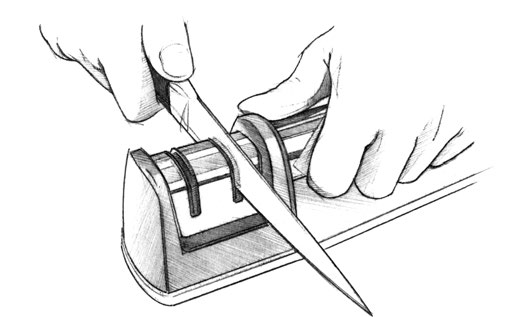Sharpening
There are usually two questions about knife sharpening: How often should it be done? What’s the best way to do it?
Predicting the frequency of knife sharpening is like trying to figure out how far a car will go on a gallon of gas: your mileage may vary. That is, some people use their knives more often than others, or use cutting surfaces that might dull their blades. So, the simple answer is to sharpen your knives when they get dull.
As for the sharpening methods, if you ask five people their opinions on how to sharpen knives, you might get six answers. The options range from having a professional sharpen your knives to doing it yourself with a sharpening device or a whetstone.
Having your knives sharpened by someone who’s a professional is almost always a good idea. This takes the worry and anxiety out of what can be a mysterious process. The only downside is going without your knives for anywhere from a day to a week, depending on who is doing the sharpening.
A variety of do-it-yourself sharpening devices are available. These are often called pull-through sharpeners, and come in electric and nonelectric styles. The decision of which one to buy rests on ease of use, your budget, and the recommendation of the person at the knife store. The benefit of these devices is clear: you get to sharpen your knives whenever it’s needed. The disadvantage is that not all sharpening devices work easily and well. If you’re not careful, you can damage your knives.
What most of these devices have in common is that you slide your knife’s blade through two
Using a whetstone is the least expensive, and most daunting, of all home-sharpening devices. While some sharpening stones are wet from using oil on them, the word “whet” actually means “to sharpen.” Since the time when we were living in caves, we have been sharpening all kinds of things on stones. Their abrasive surfaces have always been perfect to grind off just enough metal to give a very sharp edge. So what could possibly go wrong with this cost-effective method? While it’s easy to sharpen a knife on a whetstone, it takes a bit of practice to get it right. You can end up with a knife that’s duller than when you started. So what’s the secret to using a whetstone? It’s all in the angle of the knife on the stone. And practice.









